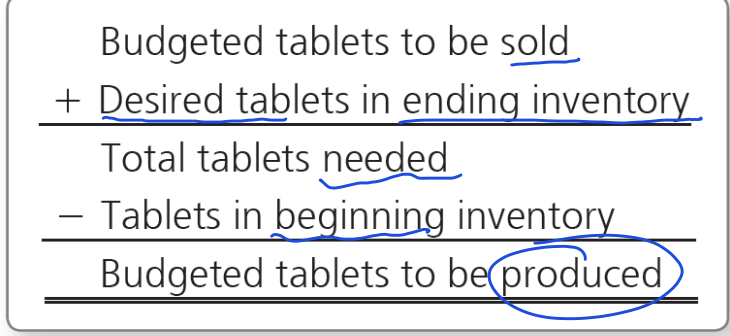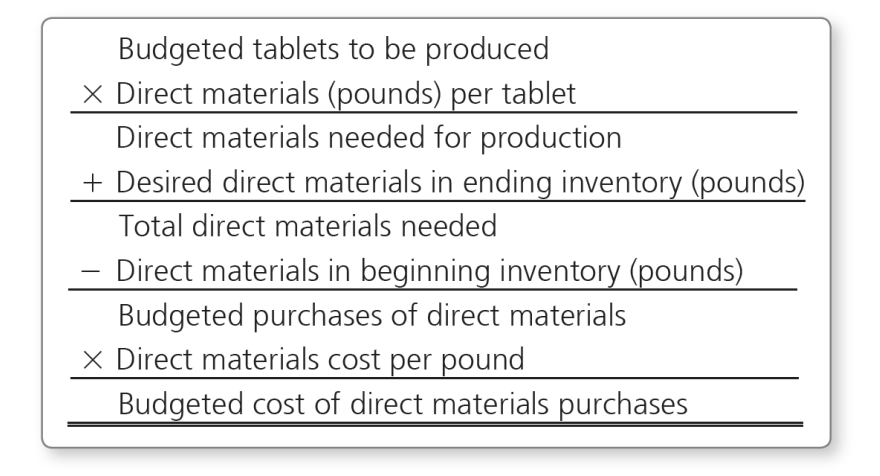Chapter 5: Master Budgets
1/43
There's no tags or description
Looks like no tags are added yet.
Name | Mastery | Learn | Test | Matching | Spaced |
|---|
No study sessions yet.
44 Terms
budget
a financial “plan” that managers use to coordinate a business’s activities
managers use budgets to:
develop strategies
plan and budget for specific actions to achieve goals
implement plans
take corrective action
budgeting objectives
develop strategies
plan
direct
control
budgeting “benefits”
requires managers to plan for the company’s future
coordinates a company’s activities
provides a benchmark that motivates employees and helps managers evaluate performance
facilitates coordination and communication
provide a benchmark that motivates employees and helps managers evaluate performance
benchmarking
the practice of comparing a company with its prior performance or with best practices from other companies
Participative budget
a budgeting process where those individuals who are directly impacted by a budget are involved in the development of the budget (bottom-up approach)
these budgets tend to be achievable because those who are directly impacted by the budget help to create the plan
managers must:
support the budget
show employees how budgets can help them achieve better results
require that employees participate in developing the budget
budgetary games:
budgetary slack
“spend it or lose it”
budgetary slack
occurs when managers intentionally understate expected revenues or overstate expected expenses
zero-based budget (ZBB)
all revenues and expenses must be justified for each new period
previous year’s actual results are ignored under this approach
strategic budget
a long-term financial plan used to coordinate the activities needed to achieve the long-term goals of the company
operational budget
a short-term financial plan used to coordinate the activities needed to achieve the short-term goals of the company
continuous budget
a type of operational budget that involves continuously adding one additional month as each month goes by
static budget
a budget prepared for only one level of sales volume
flexible budget
a budget prepared for various levels of sales volume
master budget
a set of budgeted financial statements and supporting schedules for an entire organization
three types of budgets included in the master budget:
the operating budget
the capital budget
the financial budget
operating budget
a set of budgets that projects sales revenue, cost of goods sold, and selling and administrative expenses, all of which feed into the cash budget and then the budgeted financial statements
capital expenditures budget
presents a company’s plan for purchasing long-term assets
financial budget
includes the cash budget and the budgeted financial statements
cash budget
details how the business expects to go from the beginning cash balance to the desired ending cash balances
master budget includes the following budgets:
sales budget
production budget
direct materials budget
direct labor budget
manufacturing overhead budget
cost of goods sold budget
selling and administrative expense budget
sales budget
the forecast of sales revenue is the “cornerstone” of the master budget
production budget
the basis for product costs budgets: direct materials budget, direct labor budgets, and manufacturing overhead budgets
production budget calculation

direct material budget
estimates the amount of materials to purchase to meet the company’s production needs
direct materials budget calculation

direct labor budget
estimates the direct labor hours and related cost needed to support the production budget
manufacturing overhead budget
estimates the variable and fixed manufacturing overhead deeded to meet the company’s production needs
predetermined overhead allocation rate =
total estimated overhead costs / total estimated quantity of the overhead allocation base
cost of goods sold budget
estimates the cost of goods sold based on the company’s projected sales
the cost accountant works with the office and sales managers to develop the ___________
selling and administrative expense budget
selling and administrative expense budget
estimates the selling and administrative expenses needed to meet the company’s projected sales
financial budgets include:
the cash budget
the budgeted financial statements
budgeted income statement
budgeted balance sheet
budgeted statement of cash flows
Capital expenditures budget (CAPEX)
the purchase of long-term assets is part of a strategic plan
capital expenditures are purchases of long-term assets, such as:
delivery trucks
computer systems
office furniture
manufacturing equipment
land
cash budget
pulls information from the other budgets previously prepared
cash budget has three sections:
cash receipts
cash payments
short-term financing
cash payments
capital expenditures
product costs
direct materials purchases
direct labor costs
manufacturing overhead costs
selling and administrative expenses
inventory, purchases, and cost of goods sold budget
the cost of goods sold computation shows the relationship between inventory, purchases, and ending inventory:
beginning merchandise inventory + purchases - ending merchandise inventory = COGS
the equation can be rearranged to find the amount of purchases required:
purchases = COGS + desired ending merchandise inventory - beginning merchandise inventory
budgets for a merchandising company include:
capital expenditures budget
cash budget
budgeted income statement
budgeted balance sheet
short-term financing
companies often borrow funds to maintain a minimum cash balance
sensitivity analysis
technology can make it more cost effective to conduct sensitivity analysis
sensitivity analysis is a “what if” technique that asks what a result will be if a predicted amount is not achieved or if an underlying assumption changes
sensitivity analysis provides a better understanding of how changes in sales and costs are likely to affect the company’s bottom line
examples of how companies use data analytics:
help with sales forecasting and financial planning
drive growth and operational efficiency
establish budgets and monitor them against actual results